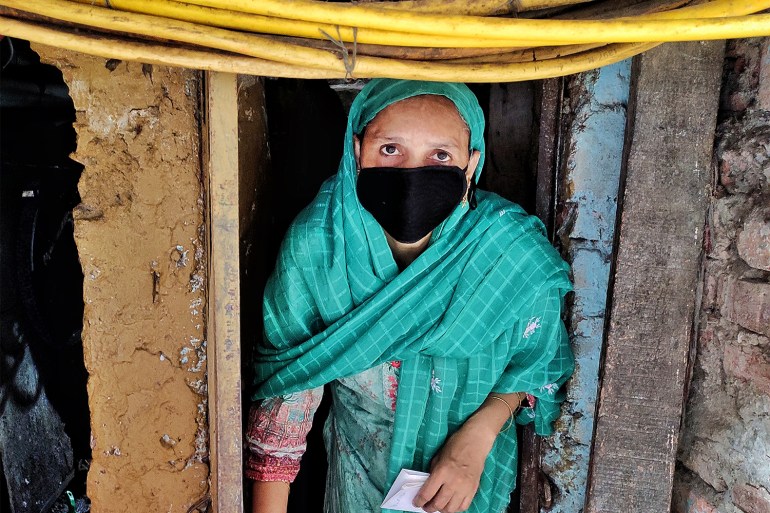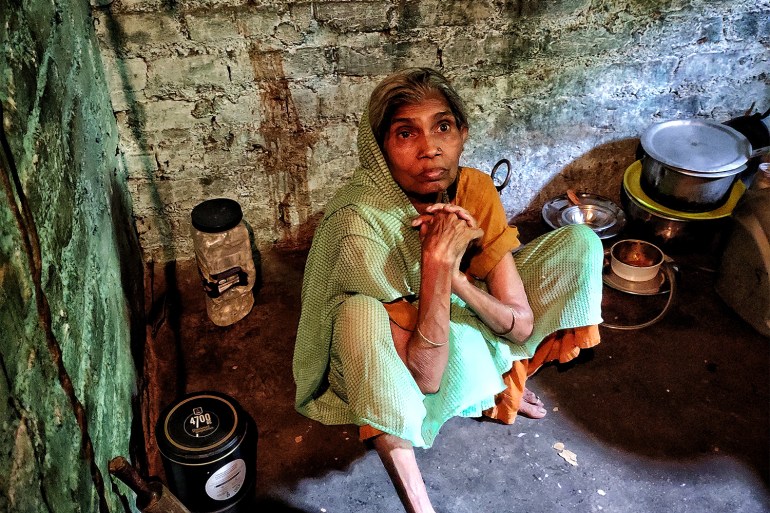New Delhi, India – Tabassum Nisha life in a shanty in a cramped corner of New Delhi’s Malviya Nagar neighbourhood with her five little ones.
The 38-yr-previous widow, who worked as a housemaid, utilized to endure on a regular monthly money of $50 when she essential much more than twice that volume to feed her kids.
Hardly ready to make ends fulfill, Nisha shed her position when a unexpected lockdown was announced by the Indian government in March past year to have the coronavirus pandemic.
She somehow fed her young children throughout the months-prolonged lockdown, trying to find compact financial loans from neighbours and shopkeepers. When they stopped assisting her, she sought enable from charities in the town.
It became ever more tricky for Nisha to feed her youngsters, and she married off her 18-yr-aged daughter in December very last year to cut down her stress.
Nisha believed the lockdown would not previous for a longer time than 2020. But one more just one was announced in April this year as the place confronted a brutal 2nd wave of the virus.
This time, there were no charities around to feed her and her kids. She claimed she survived the next lockdown on 1 meal a day.
Now the anticipation of a third COVID lockdown leaves her in panic of starving to loss of life.
 Tabbasum Nisha at her shanty in New Delhi’s Malviya Nagar neighbourhood [Srishti Jaswal/Al Jazeera]
Tabbasum Nisha at her shanty in New Delhi’s Malviya Nagar neighbourhood [Srishti Jaswal/Al Jazeera]Nisha is among hundreds of thousands of India’s poor who have been excluded from Primary Minister Narendra Modi’s flagship foodstuff stability plan, the Pradhan Mantri Ghareeb Kalyan Ann Yojana (PMGKAY). Reason: they do not very own a ration card.
The ration card is a document issued by different point out governments to households qualified to obtain subsidised meals grains from the community distribution method under the Countrywide Food items Protection Act (NFSA).
Ration playing cards dependent on 2011 census
Because 2013, Nisha has used for a ration card – 3 times. Inspite of her eligibility, it was under no circumstances issued.
The PMGKAY, which offers of remaining the greatest meals security programme in the globe, aims to feed India’s poorest throughout the pandemic. It presents five kilogrammes (11 lbs) of totally free rice or wheat and just one kilogramme (two pounds) of pulses for each particular person to each individual family members holding a ration card, in addition to common entitlements that occur with the card.
Nevertheless, Nisha can’t get a person since Delhi point out, where by she life, has fatigued its quota of the number of individuals who can be issued a ration card.
In 2021, 22 out of 29 states in India had a lot less than 5 % of their quota remaining.
That is for the reason that the quota is dependent on the 2011 census, generating it a gross undervalue. The up coming census, scheduled to be completed this 12 months, has been delayed indefinitely because of to the pandemic.
In the meantime, in a ten years, there has been a significant raise in the number of people not covered underneath the NFSA.
Take into account this. When the Delhi governing administration in 2020 announced it would give meals grains with out ration playing cards as a non permanent pandemic evaluate, on prime of the 7.3 million folks who had ration playing cards, a lot more than 6.9 million many others who did not have a card also turned up.
“Such is an undervalue of ration card quotas that practically half of Delhi’s populace that demands food security in a pandemic is excluded from the principal foodstuff stability scheme,” Amrita Johri, a member of the Suitable to Meals campaign, informed Al Jazeera.
Like Nisha, 51-year-old Rahela, who goes by 1 title, used for a ration card in 2018. Radha, 37 utilized in 2019 and Haripyari, 22, in 2021. All of them are waiting around to listen to from the federal government.
Other individuals like Rani Devi, 60, and Nuzat Bano, 22, are unable to utilize at all since of the complex specifications of eligibility, these types of as a evidence of home, electric power payments and other paperwork.
 Rani Devi, 60 sitting down in her home which also serves as kitchen, toilet and living space [Srishti Jaswal/Al Jazeera]
Rani Devi, 60 sitting down in her home which also serves as kitchen, toilet and living space [Srishti Jaswal/Al Jazeera]“If this is the affliction in the national cash, what would be the condition in India’s rural locations?” Johri questioned.
‘We also may die of hunger’
The immediate result of a faulty general public distribution program is the exclusion of India’s most vulnerable, folks presently reeling with hunger and joblessness all through a pandemic.
The phenomenon has even led to some folks starving to death.
Previous 12 months, five-yr-outdated Sonia died in neighbouring Uttar Pradesh state’s Agra city for the reason that her family members experienced nothing at all to eat for 15 times all through the coronavirus lockdown. The girl’s relatives was issued a ration card following her demise produced headlines.
“If we do not get a ration card in advance of the third wave, we also could possibly die of hunger,” Rahela, who has a spouse and children of 4 to feed, advised Al Jazeera.
The NFSA handles 50 per cent of India’s urban and 75 % of the rural population, supplying them subsidised foods grains less than the general public distribution process by way of ration playing cards.
The distribution of cards by condition was previous determined by India’s Scheduling Commission, making use of Nationwide Sample Study (NSS) Household Consumption Study details for 2011-2012.
Much more than 10 several years have elapsed considering that the publication of that facts, with gurus these kinds of as Dipa Sinha, assistant professor of economics at New Delhi’s Ambedkar University, calling it “policy blindness”.
“The government is knowledgeable of this substantial hole on paper and on the ground. They really don’t want to increase the subsidy on food stuff grains simply because raising the subsidy would immediately improve India’s fiscal deficit. This even with surplus grains obtainable in India,” Sinha instructed Al Jazeera.
 Nida Praveen’s mother Nuzat Bano has not been capable to feed her all working day. Bano, a resident of Delhi, does not have a ration card [Srishti Jaswal/Al Jazeera]
Nida Praveen’s mother Nuzat Bano has not been capable to feed her all working day. Bano, a resident of Delhi, does not have a ration card [Srishti Jaswal/Al Jazeera]At this time, India’s granaries, controlled by the Food stuff Corporation of India, are overflowing with a file 100 million metric tonnes of grains – about 3 moments the norm for buffer stock.
‘Fine line involving loss of life and life’
In Could 2020, when visuals of a large exodus of migrant employees going for walks down highways commenced actively playing on television screens, India’s Supreme Courtroom took action, unprompted.
The prime courtroom acknowledged that most migrant personnel suffering from hunger and excessive poverty were being excluded from the public distribution system since they did not have ration playing cards.
“Facing flak, the governing administration in May 2020 declared that it would provide ration to 80 million folks who do not have ration cards, but only for the months of May perhaps and June,” reported Johri.
“However, even this was not executed properly. Facts reveals that government could establish and distribute meals grains to only 28 million beneficiaries.”
Johri said states this kind of as Madhya Pradesh, Andhra Pradesh, Gujarat and Uttarakhand distributed much less than 3 percent of the foods grains sanctioned to them.
When a comparable condition arose in 2021, the authorities told the prime court docket on June 9 that its 2020 scheme experienced only been legitimate for two months and that it had instructed states to established up their possess techniques according to requirements.
Some states gave no grain to people with no ration playing cards whilst some states furnished a one particular-time aid.
In the absence of a career, Nisha reported she usually starves herself to feed her kids.
“I want to educate my young children. That is why I have not forced them into child labour. I really don’t keep in mind when I final fed them milk or eggs. We primarily take in potatoes as it is the least expensive to get,” she told Al Jazeera.
India was ranked 94th – or “alarming” – in the World-wide Hunger Index 2020 of 107 countries.
“The government is not accepting that folks are starving. There is a basic idea that lockdown causes starvation, when all is perfectly soon after that. There are no careers, the informal economic climate is vastly impacted by the pandemic and the federal government refuses to see it,” Sinha mentioned.
 Rani Devi with her two granddaughters at their shanty in New Delhi [Srishti Jaswal/Al Jazeera]
Rani Devi with her two granddaughters at their shanty in New Delhi [Srishti Jaswal/Al Jazeera]When Al Jazeera frequented Rani Devi’s shanty, she had practically nothing to take in apart from frozen body fat and salt. The 60-yr-old widow is accountable for feeding her 3 grandchildren.
Her 14-yr-old grandson is a rickshaw puller and the sole earner in the family. He earns concerning $4-5 a working day.
“The authorities does not realise that exclusion error is extra really serious than inclusion mistake. Generally, the lousy quality of cereals and grains that are furnished under the community distribution procedure is a great line among demise and existence,” Sinha told Al Jazeera.
“If Sonia’s family had a ration card, she may well continue to be malnutritioned but alive.”
In 2016, the Supreme Court docket ruled that foodstuff grains ought to not be denied in absence of a ration card to all those who have to have it.
This 12 months, the top court reiterated its buy, including that the quota should really be revised to the present-day estimates of the populace. The courtroom also directed all condition governments to present dry rations to the hungry for as long as the pandemic continues in India.
“However, no these types of scheme has been devised so much by the condition governments,” activist Anjali Bhardwaj told Al Jazeera. She said she has sent authorized notices to several states, inquiring why they failed to comply with the way of the Supreme Court docket.
In a reply to Bhardwaj on August 24, the federal ministry of customer affairs, food stuff and public distribution said any revision in quota estimates will be doable only after the publication of the following census.
“Most most likely, the subsequent census will be revealed the moment the pandemic is about. What will these men and women do through the pandemic? Will they starve?” requested Bhardwaj.
“Time and all over again, the courts have upheld not just a citizen’s correct to daily life but also citizen’s ideal to dwell with dignity. What dignity is left when a particular person is forced to beg for meals?”




